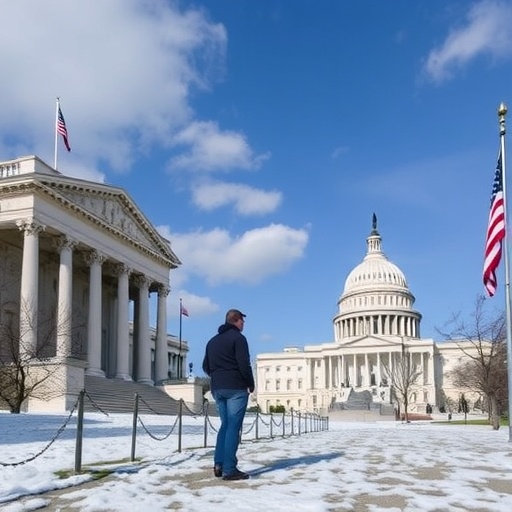US Budget deficit Slashed to 5.9% of GDP as Shutdown Standoff Intensifies Fiscal Policy Battle
In a bold move amid escalating tensions over a potential government shutdown, Treasury Secretary Scott Bessent revealed that the US Budget deficit has been trimmed to 5.9% of GDP, down from 6.4% earlier this year. This fiscal policy win comes as Republicans, holding firm control of both chambers of Congress, rebuff Democratic pushes for an additional $1.5 trillion in government spending, signaling a pivotal shift in the nation’s approach to managing its mounting debt and bolstering the economy.
The announcement, delivered during a high-stakes press briefing at the Treasury Department, underscores the administration’s commitment to reining in excessive expenditures even as partisan gridlock threatens essential federal services. “We’ve made real progress in fiscal responsibility,” Bessent declared, emphasizing that the reduction reflects targeted cuts and efficient resource allocation. “This isn’t just numbers on a page; it’s about safeguarding the American economy for generations to come.”
As the clock ticks toward a possible shutdown deadline, this development injects a note of optimism into the fiscal policy discourse, highlighting how strategic decisions on government spending can mitigate the risks posed by the nation’s staggering debt, which now exceeds $35 trillion. Economists and lawmakers alike are watching closely, with implications rippling across markets, social programs, and international trade relations.
Bessent’s Surprise Announcement Ignites Fiscal Optimism
Treasury Secretary Scott Bessent’s revelation caught many off guard, arriving just days before the contentious budget negotiations were set to reach a boiling point. In his address, Bessent detailed how the administration achieved the Budget deficit reduction through a combination of streamlined operations in non-essential programs and revenue boosts from economic growth initiatives. The drop from 6.4% to 5.9% of GDP represents a savings of approximately $150 billion annually, a figure that Bessent attributed to “prudent fiscal policy that prioritizes long-term stability over short-term political gains.”
Historical data from the Congressional Budget Office (CBO) supports the significance of this milestone. Prior to the current administration, the budget deficit hovered around 7-8% of GDP during periods of economic recovery post-pandemic, driven by unprecedented government spending on relief packages. Bessent highlighted that this latest figure marks the lowest deficit-to-GDP ratio since 2019, pre-COVID era, when fiscal policy was more restrained. “We’re turning the tide on debt accumulation,” he added, pointing to projections that sustained efforts could stabilize the economy without triggering inflation spikes.
Market reactions were swift and positive. The Dow Jones Industrial Average surged 1.2% in afternoon trading following the news, with bond yields dipping slightly as investors expressed confidence in the trajectory of US debt management. Financial analysts, including those from Goldman Sachs, noted that this reduction alleviates some pressure on interest rates, potentially freeing up capital for private sector investment and consumer spending—key drivers of the economy.
Yet, the announcement isn’t without controversy. Democratic leaders, such as Senate Minority Leader Chuck Schumer, criticized it as “smoke and mirrors,” arguing that the cuts disproportionately affect social safety nets. Schumer stated in a floor speech, “While the administration pats itself on the back for a minor fiscal tweak, families across America face the real threat of a shutdown that could halt vital services.” This rhetoric underscores the deep divides in approaches to government spending, with Democrats advocating for expanded investments in infrastructure and healthcare to stimulate the economy.
Republicans Dig In Against $1.5 Trillion Spending Demands
With Republicans maintaining a slim but decisive majority in both the House and Senate, the party has staunchly opposed Democratic proposals for $1.5 trillion in additional government spending. House Speaker Mike Johnson, a key architect of the resistance, emphasized during a caucus meeting that such outlays would exacerbate the budget deficit and balloon the national debt further. “We’re not going to mortgage our children’s future for unchecked spending,” Johnson asserted, framing the standoff as a defense of fiscal policy principles that prioritize balanced budgets over expansive programs.
The proposed spending package, outlined in Democratic budget blueprints, includes allocations for green energy transitions, affordable housing initiatives, and enhanced border security—areas where bipartisan support has historically wavered. Republicans counter that these funds could be better directed through tax incentives for businesses, which they argue would invigorate the economy without increasing debt. According to a recent Heritage Foundation report, unchecked government spending at the proposed levels could add up to 2 percentage points to the budget deficit within the next fiscal year, pushing it perilously close to 8% of GDP.
The government shutdown standoff adds urgency to these debates. As funding for federal agencies lapses without a deal, non-essential operations could grind to a halt, affecting everything from national parks to IRS processing. In past shutdowns, such as the 35-day impasse in 2018-2019, the economy suffered an estimated $11 billion in losses, per CBO estimates. Republicans, however, view the current leverage as essential for enforcing fiscal discipline. “This is about accountability,” said Sen. Lindsey Graham, a vocal proponent of the hardline stance. “Democrats must come to the table with realistic proposals that don’t undermine our fiscal policy framework.”
Behind the scenes, negotiations have been fraught. Sources close to the talks reveal that informal discussions have explored compromises, such as capping new spending at $800 billion while tying increases to deficit-reduction triggers. However, with midterm elections looming, both sides appear reluctant to yield, heightening the risk of prolonged disruption to government spending and, by extension, the broader economy.
Economic Ripples from Deficit Trim and Shutdown Risks
The reduction in the budget deficit to 5.9% of GDP carries profound implications for the US economy, offering a buffer against inflationary pressures and interest rate hikes. Economists at the Federal Reserve have long warned that persistent deficits fuel debt servicing costs, which currently consume over 10% of federal revenues. By curbing the deficit, the administration aims to redirect funds toward productive investments, such as education and research, potentially boosting long-term GDP growth by 0.5% annually, according to Moody’s Analytics projections.
However, the specter of a government shutdown tempers this optimism. Shutdowns disrupt not only federal payrolls—impacting 2.1 million civilian employees—but also private sector confidence. A study by the US Travel Association estimates that even a short shutdown could cost the economy $200 million per day in lost tourism and related revenues. For businesses reliant on government contracts, the uncertainty translates to delayed projects and hiring freezes, stifling economic momentum.
Fiscal policy experts weigh in on the dual dynamics. Dr. Elena Ramirez, a professor of economics at Georgetown University, commented, “This deficit reduction is a step in the right direction for debt sustainability, but a shutdown would undo much of that goodwill by introducing volatility into government spending patterns.” She further noted that sustained fiscal restraint could lower the debt-to-GDP ratio from its current 120% to below 100% by 2030, provided spending growth aligns with revenue increases.
On the international front, the news bolsters the dollar’s strength against major currencies, as global investors perceive improved US fiscal policy as a sign of stability. Yet, rising debt concerns have prompted calls from institutions like the IMF for more aggressive measures. The IMF’s latest World Economic Outlook urges the US to address structural deficits through entitlement reforms, warning that without action, government spending could crowd out private investment, hampering economy-wide productivity.
Consumer sentiment, as measured by the University of Michigan’s index, has ticked up slightly post-announcement, with households expressing relief over perceived fiscal prudence. Nonetheless, polls indicate widespread anxiety over shutdown scenarios, with 62% of respondents in a recent Gallup survey fearing impacts on Social Security payments and veterans’ benefits.
Tracing the Roots of America’s Fiscal Challenges
To fully grasp the import of the current budget deficit reduction, one must delve into the historical context of US fiscal policy. The nation’s debt trajectory accelerated dramatically during the 2008 financial crisis and the COVID-19 pandemic, when government spending surged to $6.6 trillion in fiscal year 2020 alone—more than double pre-crisis levels. These interventions, while stabilizing the economy, left a legacy of elevated deficits, peaking at 14.9% of GDP in 2020.
Subsequent years saw incremental improvements, but partisan battles over government spending have repeatedly stalled progress. The 2011 debt ceiling crisis, for instance, led to a credit rating downgrade by S&P, spiking borrowing costs and rattling markets. Fast-forward to today, and the budget deficit stands as a flashpoint in congressional debates, with Republicans championing austerity measures and Democrats pushing for targeted investments to address inequality and climate change.
Key statistics paint a stark picture: Annual interest payments on the debt now exceed $800 billion, surpassing expenditures on defense or Medicare. The CBO forecasts that without fiscal policy adjustments, the debt could reach 180% of GDP by 2050, posing risks to economic sovereignty. Bessent’s team has drawn on lessons from past administrations, incorporating elements of the 1990s balanced budget era, when bipartisan pacts reduced deficits through spending caps and tax reforms.
Stakeholders beyond Washington are feeling the pinch. State governments, grappling with their own budget shortfalls, lobby for federal aid, while Wall Street titans like Jamie Dimon of JPMorgan Chase have publicly urged restraint. “Unchecked debt undermines the foundations of our economy,” Dimon wrote in his annual shareholder letter, echoing calls for a comprehensive overhaul of government spending priorities.
In this landscape, the 5.9% deficit figure emerges as a beacon of potential reform, though its longevity depends on navigating the shutdown impasse and forging a consensus on fiscal policy.
Navigating Future Fiscal Waters: Debt Projections and Policy Pathways
Looking ahead, the budget deficit’s reduction sets the stage for ambitious fiscal policy reforms, but challenges abound. The administration’s blueprint envisions further cuts to 4.5% of GDP by 2026, contingent on economic growth outpacing spending. This could involve overhauling tax codes to broaden the base, potentially generating $500 billion in additional revenue over a decade, per Joint Committee on Taxation estimates.
Yet, the government shutdown threat looms large. If unresolved, it could derail deficit progress by necessitating emergency spending to cover backlogs, inflating the debt anew. Bipartisan task forces are being floated as a solution, with proposals for automatic stabilizers that adjust government spending based on economic indicators— a mechanism to prevent future standoffs.
Experts forecast varied outcomes. Optimists, like those at the Peterson Institute for International Economics, predict that disciplined fiscal policy could enhance the economy’s resilience, fostering job creation in high-growth sectors. Pessimists warn of austerity’s downsides, citing Europe’s post-2008 experience where rapid deficit cuts stifled recovery.
Internationally, allies and adversaries alike monitor US debt dynamics. A stable fiscal posture strengthens America’s negotiating power in trade deals and geopolitical arenas, while vulnerabilities could embolden challenges to the dollar’s reserve status. As Bessent concluded in his briefing, “The path forward demands unity on fiscal responsibility—our economy’s future hangs in the balance.” With Congress reconvening next week, the coming days will test whether this momentum translates into lasting government spending reforms and a fortified economic foundation.








